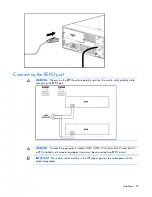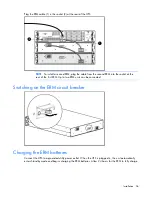
UPS operations 30
NOTE:
Configure mode times out after 2 minutes of inactivity. If the Test/Alarm Reset button
has not been pressed, any new selections are not saved.
For the location of buttons, see "UPS front panel controls (on page
7
)."
For the location of LEDs, see "UPS front panel LED indicators (on page
8
)."
Available voltage settings
NOTE:
An asterisk (*) indicates the default setting.
UPS model
Available settings utility voltage (VAC)
Associated LED ("
UPS
front panel LED
indicators
" on page
8
)
R3000 NA
100
General Alarm
110
On Battery
120*
Battery Fault
127
Site Wiring Fault
R3000j JPN
100*
General Alarm
110
On Battery
120
Battery Fault
127
Site Wiring Fault
R3000h NA, R3000h JPN
200/208*
General Alarm
220
On Battery
230
Battery Fault
240
Site Wiring Fault
R3000 INT
200/208
General Alarm
220
On Battery
230*
Battery Fault
240
Site Wiring Fault
Initiating a self-test
To initiate a self-test, press and hold the Test/Alarm Reset button ("
UPS front panel controls
" on page
7
)
for three seconds.
Because a portion of the self-test requires battery power, the self-test cannot be initiated if the batteries are
less than 90 percent charged. If the UPS detects a problem, the appropriate LED ("
UPS front panel LED
indicators
" on page
8
) illuminates and an audible alarm may sound.
For information on what to do if the self-test detects a problem, see "Troubleshooting (on page
41
)."
















































